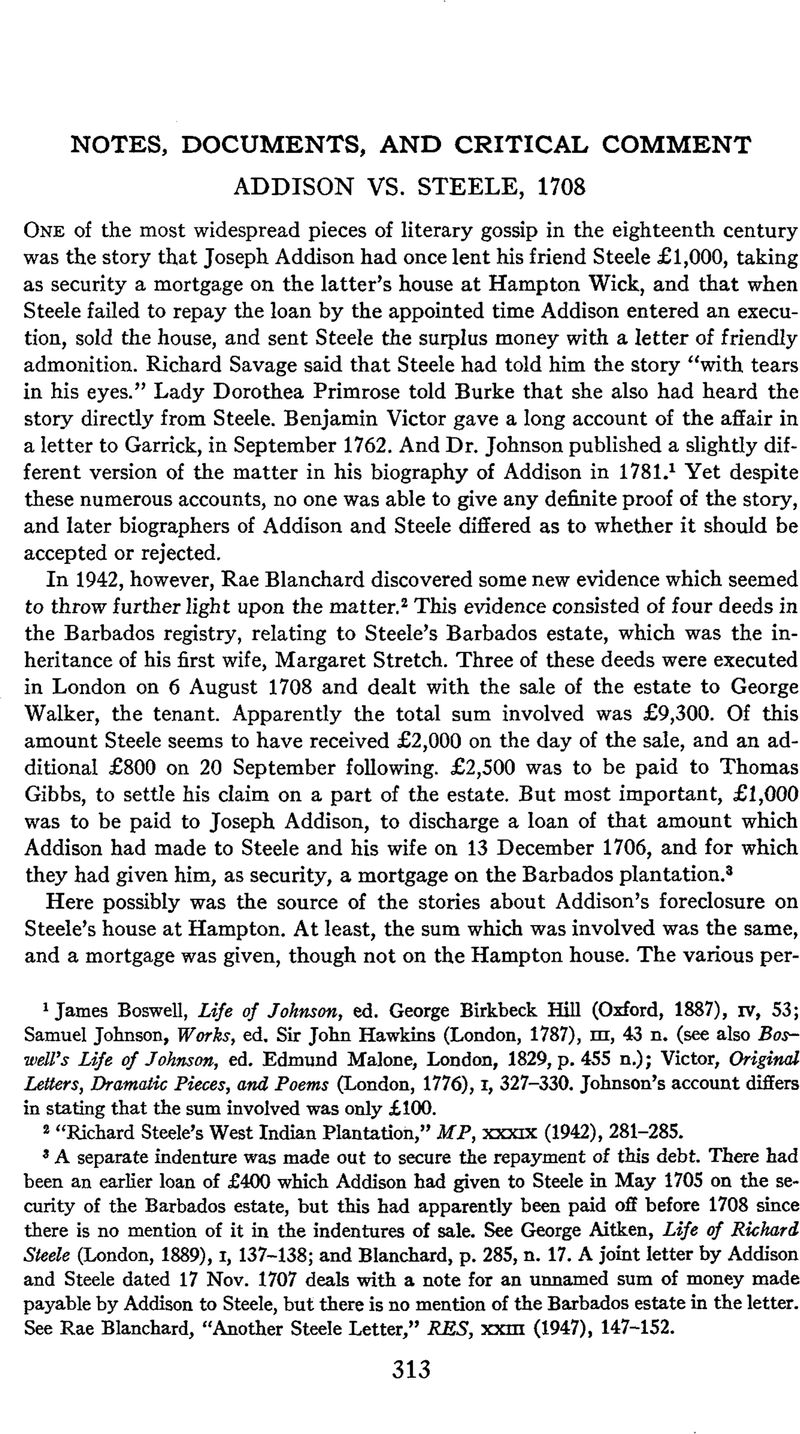No CrossRef data available.
Article contents
Addison vs. Steele, 1708
Published online by Cambridge University Press: 02 December 2020
Abstract

- Type
- Notes, Documents, and Critical Comment
- Information
- Copyright
- Copyright © Modern Language Association of America, 1953
References
1 James Boswell, Life of Johnson, ed. George Birkbeck Hill (Oxford, 1887), iv, 53; Samuel Johnson, Works, ed. Sir John Hawkins (London, 1787), iii, 43 n. (see also Boswell's Life of Johnson, ed. Edmund Malone, London, 1829, p. 455 n.); Victor, Original Letters, Dramatic Pieces, and Poems (London, 1776), i, 327-330. Johnson's account differs in stating that the sum involved was only £100.
2 “Richard Steele's West Indian Plantation,” MP, xxxix (1942), 281-285.
3 A separate indenture was made out to secure the repayment of this debt. There had been an earlier loan of £400 which Addison had given to Steele in May 1705 on the security of the Barbados estate, but this had apparently been paid off before 1708 since there is no mention of it in the indentures of sale. See George Aitken, Life of Richard Steele (London, 1889), i, 137-138; and Blanchard, p. 285, n. 17. A joint letter by Addison and Steele dated 17 Nov. 1707 deals with a note for an unnamed sum of money made payable by Addison to Steele, but there is no mention of the Barbados estate in the letter. See Rae Blanchard, “Another Steele Letter,” RES, xxiii (1947), 147-152.
4 I wish to acknowledge the valuable aid of Miss Sylvia England in searching through the files of the P.R.O.
5 It is possible that the day of the month may be 17 instead of 7; the MS. is very worn and almost illegible at this particular point.
6 It was often the practice in Chancery files to attach to the original plea only the first answer received; later answers might be filed in other bundles as they came in. Since there is no index to these stray answers, it is very difficult to locate them.
7 The surplus of the money received from the sale was to be paid to Steele in two installments on 25 June 1709 and 25 June 1710; this is in accord with the deeds registered in Barbados. But it is significant that Tryon makes no mention of any payment to Steele on the day of the sale, whereas in the Barbados records there is a receipt for £2,000, apparently paid Steele at that time. It seems questionable as to whether he actually received this amount, however; see Blanchard, “Steele's West Indian Plantation,” p. 283.
8 Tryon was a shrewd and rather shady agent for the Barbados planters, and also a close friend of the governor, as appears from a letter written by the governor to the Duke of Newcastle on 8 August 1707 (B.M. Harleian MS. 7523, f. 280). This letter also contains the following interesting passage: “Indeed amongst all our Greavences I thinke 7 or Eight Barresters the Cheafest who made a Menopiley of all the Poore Contending Planters Estates and he thatt gave the best fee was Suire to have them all and I am afraid—The Judge On his Side.” Obviously, if Tryon could get this case referred to the authorities in Barbados, Addison would have little chance of ever getting his £1,000.
9 Correspondence of Richard Steele, ed. Rae Blanchard (Oxford, 1941), p. 31.
10 Letters of Joseph Addison, ed. Walter Graham (Oxford, 1941), p. 263.
11 On 3 July 1710 the London papers carried the announcement of Gulston Addison's death (British Mercury, 43); I am indebted to Mr. Peter Smithers, M.P., for this information. Addison, who was then in Dublin, probably received the news shortly thereafter.
12 In addition, there is in the Aitken collection of MSS. at the Univ. of Texas a letter from Bernard Benyon to Addison, dated 10 Jan. 1711/12, in which Benyon says that the trustees are sending Addison a thousand pagodas by the next ship, and adds: “I hope before the next opportunity of writting you, I shall have compleated all accts & paid off the Legacy's.” This letter was not included by Graham in his edition.
13 Letters, pp. 270-272.
14 Ibid., pp. 309-312. The date in B.M. Egerton MS. 1972, ff. 83-84, is 20 Jan. 1713/14.
15 Addison's figure of £14,000 differs from the purchase price as given by Blanchard of £9,300. Apparently, however, the Barbados deeds were not entirely definite on this point, for Blanchard says: “This inclusive sum, which apparently included some rent, seems to have been £9,300.” Addison may have been guessing at the total value of the estate, basing his judgment on the yearly rental, which he gives in his plea as £850.
16 For illustrations of their personal relations during this time see Steele's Correspondence, pp. 231-232, 238, 249. The only indication of any possible ill feeling during this period is a very ambiguous passage in a letter to Prue, 26 Nov. 1708: “I am by applying to my Adversary prepar'd for ending my present calamity, but was deny'd by my Freind.” If the friend referred to was Addison, the passage might indicate that Addison had refused to lend Steele any additional money at this time; but the friend in question may not have been Addison at all.
17 Ibid., p. 234. According to the Barbados deeds, Steele was to have been paid £800 (possibly of back rent) on 20 Sept.
18 Ibid., p. 235. Cf. his letter of 1 Oct. 1708: “I have been so much employ'd in settling some businesse to prevent being Cheated by a Sett of Shuffling fellows that I could not get out of Town.”
19 Ibid., p. 245. Notice the implication that Addison's suit is against Tryon and not against Steele. According to Addison's Chancery plea, Tryon had denied having any effects of George Walker.
20 Ibid., p. 252; see also pp. 253, 257-258.
21 Ibid., p. 259.
22 Ibid., p. 274.




